Sep 4, 2013 | administrative, Israel, medals
To all my Jewish readers,
L’shanah tovah tikatev v’taihatem
May you be inscribed and sealed for a good year
This is the earliest that Rosh Hashanah has appeared on the Gregorian Calendar since 1899. Later this year, Chanukah and Thanksgiving will occur on the same day for the first time in history. With the nuances of the calendars, this will not happen again for 77,789 years.
It will be 5774 on the Jewish calendar which is a leap year. Since the Jewish calendar is lunisolar, a calendar whose date indicates both the moon phase and the time of the solar year, a leap year adds one month to the calendar. Adar I will begin on February 1 and last for 29 days. All Adar holidays, such as Purim, occur in Adar II.
A Happy and Healthy New Year to you and your family!
May 13, 2012 | currency, Israel
It has been a while since I wrote about a new purchase, mainly because I have not made many new purchases. The few I have made were to fill a few holes in a Barber Quarters and Barber Halves collection that I am doing for fun. I have picked up a few error coins that were not exciting. But this is the first time in a few months that I made a purchase that really excites me.
A few years ago I sat at a table at one of the Whitman Expos in Baltimore when I came across a dealer who was selling later issues of Israeli currency for inexpensive prices. I had seen a few pieces that intrigued me so I purchased what I could. Not long after, I found two books about the currency issues from the Bank of Israel and I decided to try to collect a sample from every series including the first two issue from the Anglo-Palestinian Bank and Bank Leumi after the founding of the State of Israel.
Last year I learned that the Bank of Israel was holding a public competition for the design of new bank notes. These notes will replace the current Second New Sheqalim series that was first issued in 1999. As a collector, it meant trying to get samples from the current series.
Luckily for me, my nephew is going to school in Israel and since he was spending his Spring/Passover Break in the United States, I decided to take advantage of his presence in the Holy Land to visit local banks to find nice notes for his uncle. Since I already have a 20 New Sheqalim polymer note, I was interested in the 50, 100, and 200 NIS notes. At the prevailing exchange rate, the cost would be under $95 for the set.
After sending the check to my brother to deposit into my nephew’s U.S.-based bank account, he went out looking for clean notes. According to my nephew, that is where the fun begins. First, he is in a school that is basically in the middle of nowhere—somewhere between Jerusalem and Tel Aviv near a land area not suitable for building. But since he had been traveling to Jerusalem, he would check the banks there.
Apparently, collecting currency is not a popular hobby in Israel because when he went to the banks they questioned his motivation. The story of the strange looks and comments by Israeli tellers and other bank personnel says that either there are not many numismatists in Israel or that they find other ways to purchase their collection than from the banks. I was amused by my nephew’s stories. He was a real trooper and found three notes that he carried back the the United States for his uncle’s collection! He’s also doing well in school, which is very important!
All three notes are from the 5766/2006 (third) printing with updated signatures and in either crisp or almost uncirculated condition. All three have nice colors and really display well, including the security features which are difficult to image. All the text on the obverse is in Hebrew using numbers for the denomination for easy identification. The reverse also includes the denomination information in both English and Arabic making Israel one of the few countries to include three languages on its currency (India is another).
The three notes are signed by Stanley Fischer, the Governor of the Bank of Israel, and Chairman of the Advisory Council, Aharon Fogel. Because of a change in the law that abolished the Advisory Council, notes printed after 5770/2010 only have the signature of Governor Fischer.
The 50 NIS note features the portrait of Shmuel Yosef Agnon sitting in his study and personal library with a pen in his hand. The text is from his acceptance speech when he was award the Nobel Prize for Literature in 1966. The reverse is a picture of Agnon’s writing stand with his pen and reading glasses. Listed over the paper on the writing stand are the titles of sixteen books written by Agnon. That list is in Hebrew.
The 100 NIS note features the portrait of Izhak Ben-Zvi, the second President of Israel, with the interior of the wooden structure that served as the President’s residence. Also featured on the obverse is text from the speech Ben-Zvi gave to the first assembly of the Yemenite community that was held at his residence in 1953. The reverse is the image of the synagogue in the Galilee village of Peki’in along with the text from the speech from his second inauguration. To the right over the windows panes (seen in red) is microtext are the titles of nine books written by Ben-Zvi.
The 200 NIS note features the portrait of Zalman Shazar, Israel’s their President with the image of students in an elementary school class. The text is from Shazar’s address to the Knesset on June 13, 1949 after the Compulsory Education Law was passed. The reverse features a typical alley in the town of Safed, a spiritual center of Kabbalists. Text is an excerpt from Shazar’s essay, “Tzofayih Tzefat” (Thy Watchers, O Safed), first published in 1950. To the right of the text is microtext featuring the titles of fifteen of Zalman Shazar’s works.
These notes are beautiful and they tell parts of Israel’s history. Digital images cannot convey how the security features, color shifting ink, subtle changes in color tone are well integrated into the notes making them works of art. One of the more interesting fetters are the triangles that appear on both sides of the note. If you hold the note up to the light, the triangles are lined up to reveal the Star of David.
The United States tried to use currency as a means to teach the people something. The Educational Series of 1896 tried to use allegorical figures with various themes. But the controversy of using a bare breasted woman on the $5 note derailed the series. These are amongst the Top 100 notes identified in 100 Greatest American Currency Notes by David M. Sundman and Q. David Bowers. In fact, very few small-sized notes made the list—only special issues like the Hawaii overprint note made for World War II. Even though the Bureau of Engraving and Printing has dabbled in color, maybe they should learn from a country like Israel and come up with more historic and iconic designs.
Apr 4, 2010 | bullion, coins, foreign, Israel
 In their last catalog, the Israel Coins and Medals Corporation, the exclusive manufacturer and distributor of coins and medals issued by the Bank of Israel, announced the “Jerusalem of Gold” bullion coin series, an annual series that will depict famous Jerusalem landmarks. The coin will contain one troy ounce of .9999 pure gold and will have a face value of 20 New Sheqalim. There will be a maximum mintage of 3,600 coins.
In their last catalog, the Israel Coins and Medals Corporation, the exclusive manufacturer and distributor of coins and medals issued by the Bank of Israel, announced the “Jerusalem of Gold” bullion coin series, an annual series that will depict famous Jerusalem landmarks. The coin will contain one troy ounce of .9999 pure gold and will have a face value of 20 New Sheqalim. There will be a maximum mintage of 3,600 coins.
According to the ICMC catalog, “The coin will bear a roaring lion with a beautiful curved tail, take from a 2,800-year-old ancient seal dating from the 8th century BCE, discovered in archeological digs at Armageddon (Megiddo). The roaring lion is the symbol of Jerusalem and the Kingdom of Judah and it has appeared on Israel circulation coins, the 5 Lira Coin of 1978 and the Half Sheqel Coin of 1980.
“The reverse of the first coin will picture the Tower of David, located near Jaffa Gate in the Old City of Jerusalem. The Tower of David was constructed during the second century BCE and rebuilt in succession by the Christian, Muslim, Mamluk and Ottoman conquerors of Jerusalem. It is a well-known landmark, housing a museum and hosting varied cultural events associated with the history of Jerusalem.”
Coins are schedule to be released on Jerusalem Day, May 12, 2010. The price was not provided in the catalog.
Image courtesy of the Israel Coins and Medals Corp. scanned from their catalog.
May 7, 2008 | BEP, cents, coin design, coins, currency, gold, Israel, legislative, US Mint
It has been a week since my last post and I thought an update was in order. I will follow up with a post for some of these at another time. This will give me something to do while proctoring the final exam in an information security course I am teaching this semester.
I recently received four polymer 20 New Israeli Shekelim notes from a dealer in Israel. These notes are the first that Israel is producing on polymer “paper” that was developed by the The Reserve Bank of Australia. Israel is another in the growing list of countries to start using the polymer material. The notes include the same security features as rag-based notes and include a new clear window with a watermark that is said to be extremely difficult to counterfeit. While the polymer substrate costs little more and the production is only marginally more expensive, the benefit will come from the reduction in counterfeiting and the durability of the note. Polymer will last three-to-six times longer than rag-based paper.
According to unconfirmed reports, the Bureau of Engraving and Printing is experimenting with different types of polymer paper for both US and foreign production. If the BEP can adjust their equipment to print on polymer paper, they can solicit business from other countries to produce their currency. Once the BEP builds its portfolio, they are prepared to go to congress to recommend discontinuing production of the one-dollar note. Until then, the BEP will continue to produce one-dollar notes in order to keep workers in key congressional districs in the Washington, DC and Fort Worth, TX areas employed. Remember, 95-percent of the BEP’s production are for one-dollar federal reserve notes.
The spot price of gold continues to drop as the dollar gains against the Euro and the Pound. Prices are returning to pre-2008 levels. However, buyers of gold collectors coins from the US Mint has not seen their prices reduced. While the Mint repriced gold and platinum coins in February and March, the Mint has not lowered their prices with the market. The one-ounce American Gold Eagle proof coin is still $1,199.95, the new price given in February. With gold closing at $876.88 today, the $327.07 premium is 36.8-percent higher than the spot price. This will cause problems for those who buy at thiese prices when reselling these coins.
While we are talking about gold, the Original Saint-Gaudens Double Eagle Ultra-High Relief Bullion Coin Act was simultaneously introduced in both the House (H.R. 5614) and Senate (S. 2924). These identical bills will allow the Mint to strike high-relief $20 gold pieces using the Augustus Saint-Gaudens original 1907 design. The date will be in roman numerals and the motto “In God We Trust” will be added over the rising sun as it appeared in 1908. The coin will be on a double-thick, 24-karat gold planchet (sometimes called a piefort) 27 millimeters in diameter.
The US Mint finally posted its online product schedule for the rest of the year. The only thing that jumps out at me is that the 2008 American Buffalo 24-karat gold proof coin is not listed.
On Tuesday, the House of Representatives began to debate H.R. 5512, the Coin Modernization and Taxpayer Savings Act of 2008. The primary provisions of the bill will allow the US Mint to determine the size and composition of US coins without having to ask congress for permission. It also specifies that following 2009, the one-cent coin would be “be produced primarily of steel and treated to impart a copper color to its appearance similar to one-cent coins produced of a copper-zinc alloy.” Debate was cut off on procedural grounds by Republican lawmakers who oppose the bill.
It was just another uneventful week!
Jul 2, 2007 | Baltimore, Canada, coins, currency, Israel, personal, registry sets, shows
When Friday rolled around, I needed a break. I needed something to take my mind off the daily grind of trying to guide the government to do right with technology. I needed coins. Lots of coins. More coins than can be experienced even when contained under one roof. I needed the Whitman Baltimore Coin and Currency Convention.
After sleeping in, I woke to kiss my wife goodbye and started to pack my backpack. Into the bag went the current editions of the Coin Dealer Newsletter, my Palm T|X that stores my inventory list, my iPod for the trip to Baltimore, and a loupe. I finished my morning constitutional before feeding and walking the dog. After a bite to eat and throwing two bottles of water in my backpack, I was off to Charm City.
The trip to Baltimore is a little more than an hour from home. It is a trip down I-270, across the top of the Capital Beltway, then north on I-95. The trip down I-395 into Baltimore passes M&T Bank Stadium, home of the Baltimore Ravens, to the warehouse beyond right field at Camden Yards home of the Baltimore Orioles. I parked in my usual lot at the Sheraton and walked through the hotel to the walkway to the Baltimore Convention Center.
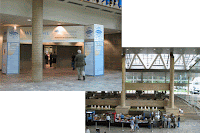 This is Whitman’s second time running this show and their mark was seen riding down the escalator when I noticed that the food court was moved. Rather than being outside the door, the service area was moved to the front lobby at the foot of the escalator. The tables were moved out closer to the lobby and Whitman placed convention-style booths for registration. Also, the entrance had a new canopy announcing the show. It looked more professional than in the past.
This is Whitman’s second time running this show and their mark was seen riding down the escalator when I noticed that the food court was moved. Rather than being outside the door, the service area was moved to the front lobby at the foot of the escalator. The tables were moved out closer to the lobby and Whitman placed convention-style booths for registration. Also, the entrance had a new canopy announcing the show. It looked more professional than in the past.
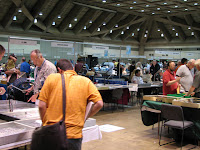 It is still an awe inspiring experience to walk into the hall and see wall-to-wall dealer tables. Adding to the depth of vision was the framing that Whitman used during the last show behind the tables to allow dealers to hang banners. As I began to walk to the left side of Hall A, I noticed that Whitman placed stickers on the floor to mark the row numbers. Looking up, on the columns, they also placed numbered signs showing row numbers and the table number group. The best way I can describe this is that the numbers resemble address numbers on street signs. It is a small touch, but when looking for a specific dealer it really helps.
It is still an awe inspiring experience to walk into the hall and see wall-to-wall dealer tables. Adding to the depth of vision was the framing that Whitman used during the last show behind the tables to allow dealers to hang banners. As I began to walk to the left side of Hall A, I noticed that Whitman placed stickers on the floor to mark the row numbers. Looking up, on the columns, they also placed numbered signs showing row numbers and the table number group. The best way I can describe this is that the numbers resemble address numbers on street signs. It is a small touch, but when looking for a specific dealer it really helps.

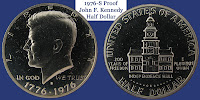 I saw a number of dealers I have bought from and spoken with in the past. Of note I was able to speak with Wayne Herndon, author of the last-page article in July’s Numismatist. The article is really good dry, tongue-in-cheek humor that I found fit Wayne’s personality when you talk with him. Wayne is a good guy and a very fair dealer. From Wayne, I was able to find some 1976 coins that I want to submit to NGC for the registry set. Finding really nice Eisenhower Dollars is very difficult, but Wayne had this 1976-D Type 1 Dollar that I could not pass up. Amongst the other coins I bought was a 1976-S Proof JFK Half Dollar is beautiful.
I saw a number of dealers I have bought from and spoken with in the past. Of note I was able to speak with Wayne Herndon, author of the last-page article in July’s Numismatist. The article is really good dry, tongue-in-cheek humor that I found fit Wayne’s personality when you talk with him. Wayne is a good guy and a very fair dealer. From Wayne, I was able to find some 1976 coins that I want to submit to NGC for the registry set. Finding really nice Eisenhower Dollars is very difficult, but Wayne had this 1976-D Type 1 Dollar that I could not pass up. Amongst the other coins I bought was a 1976-S Proof JFK Half Dollar is beautiful.
Watch out NGC, these coins (and other coins) will be sent this week!
One thing I noticed was that there was a lot of table sharing. While this is a common practice with small dealers, there were some higher volume dealers sharing tables, especially on the corners. For the buyer, this meant that there were more options. I was able to pickup some nice items while junk box diving for resale that I will be posting on eBay soon. Yes, there were some nice items in many of the junk boxes which was surprising.
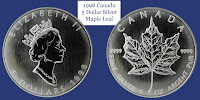 I also had taken the opportunity to try to complete my set of Silver Maple Leaf coins. I was able to find a 1989, 1992, 1996, and 1998. All I am missing from the set is 1990 and 2007. I forgot about the 2007 and did not buy one at the show. All are beautiful coins, but the 1998 is the best. Images of these coins are difficult, but I tried so I can show off their beauty.
I also had taken the opportunity to try to complete my set of Silver Maple Leaf coins. I was able to find a 1989, 1992, 1996, and 1998. All I am missing from the set is 1990 and 2007. I forgot about the 2007 and did not buy one at the show. All are beautiful coins, but the 1998 is the best. Images of these coins are difficult, but I tried so I can show off their beauty.
 As I complete many of my United States sets, I am looking for other areas to explore. One area of interest is the currency of Israel. Coins are interesting, but the Israeli paper is beautiful with nice historical images. But first, I wanted the 2005 Theory of Relativity Commemorative Proof. I purchased a beautiful proof coin from noted dealer in Israeli Numismatics, J.J. van Grover. Van Grover is also the Vice President of the American Israel Numismatic Association, an organization which I recently joined, and we had a chance to talk about AINA and other Israeli issues. But the coin is beautiful whose image cannot do it justice.
As I complete many of my United States sets, I am looking for other areas to explore. One area of interest is the currency of Israel. Coins are interesting, but the Israeli paper is beautiful with nice historical images. But first, I wanted the 2005 Theory of Relativity Commemorative Proof. I purchased a beautiful proof coin from noted dealer in Israeli Numismatics, J.J. van Grover. Van Grover is also the Vice President of the American Israel Numismatic Association, an organization which I recently joined, and we had a chance to talk about AINA and other Israeli issues. But the coin is beautiful whose image cannot do it justice.
I did buy some Israeli paper money. These two notes are from the Fourth Series Pounds dated 1973 but issued in 1975. These notes were demonetized in 1983.
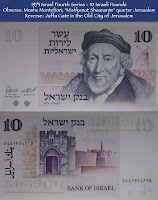

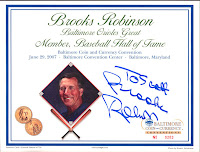 Before going through the rest of the show floor, it was time to take a pause to do something non-numismatic. Appearing at the show was Baltimore Orioles Great and Member of the Baseball Hall of Fame, Brooks Robinson. Robinson is a very gracious gentleman whose current wrist injury he blames on old age. At 70, he may not be able to defend the hot corner but he is not ready for the home either. I did stand on line for his autograph and have my picture taken. Even though my Mets beat his Orioles in 1969, I cannot deny that he was a great player and a classy person. It was a joy to meet him.
Before going through the rest of the show floor, it was time to take a pause to do something non-numismatic. Appearing at the show was Baltimore Orioles Great and Member of the Baseball Hall of Fame, Brooks Robinson. Robinson is a very gracious gentleman whose current wrist injury he blames on old age. At 70, he may not be able to defend the hot corner but he is not ready for the home either. I did stand on line for his autograph and have my picture taken. Even though my Mets beat his Orioles in 1969, I cannot deny that he was a great player and a classy person. It was a joy to meet him.
 Before returning to the bourse floor, I stopped at the nearby Whitman booth. During registration, we were given a coupon for a free copy to The Expert’s Guide to Collecting & Investing in Rare Coins, the latest tome from Q. David Bowers, with a $25 purchase. I almost walked away from the booth before noticing Whitman was selling something that was not numismatic or philatelic related. Whitman now creates something called Football Vault Books. With the publisher from the south, it is not surprising that the series started to cover the Southeastern Conference. When I found the University of Georgia Vault Book I decided to use my coupon after buying the book. The Vault Book is fantastic! It has the history and reproduction of memorabilia from the era being discussed. Ok… back to the coins.
Before returning to the bourse floor, I stopped at the nearby Whitman booth. During registration, we were given a coupon for a free copy to The Expert’s Guide to Collecting & Investing in Rare Coins, the latest tome from Q. David Bowers, with a $25 purchase. I almost walked away from the booth before noticing Whitman was selling something that was not numismatic or philatelic related. Whitman now creates something called Football Vault Books. With the publisher from the south, it is not surprising that the series started to cover the Southeastern Conference. When I found the University of Georgia Vault Book I decided to use my coupon after buying the book. The Vault Book is fantastic! It has the history and reproduction of memorabilia from the era being discussed. Ok… back to the coins.
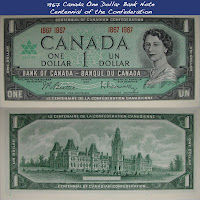 This time, the foreign section was smaller than usual. I was looking for some Canadian coins but was a little disappointed at the selection and the lack of dealers with good Canadian inventory. Rather than walk away empty handed, I bought a 1967 Centennial of the Confederation One Dollar note. It is a crisp, uncirculated note that has a look very reminiscent of the formal aspects of the 1960’s.
This time, the foreign section was smaller than usual. I was looking for some Canadian coins but was a little disappointed at the selection and the lack of dealers with good Canadian inventory. Rather than walk away empty handed, I bought a 1967 Centennial of the Confederation One Dollar note. It is a crisp, uncirculated note that has a look very reminiscent of the formal aspects of the 1960’s.
 As the day was winding down, I needed to buy something old. Somebody had to have something not that expensive but old and fun. I happened upon the table for The Butternut Company out of Clifton, Virginia. Butternut has a nice business of Civil War memorabilia along with the coins. But the had a junk box of well worn large and half cents. Ah ha! Something old! So I searched the small box looking for something with a readable date. In the box I found an 1803 Large Cent that satisfied my old and fun criteria. It is 204 years old and is just loaded with history.
As the day was winding down, I needed to buy something old. Somebody had to have something not that expensive but old and fun. I happened upon the table for The Butternut Company out of Clifton, Virginia. Butternut has a nice business of Civil War memorabilia along with the coins. But the had a junk box of well worn large and half cents. Ah ha! Something old! So I searched the small box looking for something with a readable date. In the box I found an 1803 Large Cent that satisfied my old and fun criteria. It is 204 years old and is just loaded with history.
As I left with ten minutes to closing, dealers were already closing down and vacating. I walked through the Sheraton, purchased a beverage and candy bar from the hotel shop, and retrieved my car from their lot. I left driving around traffic on their way to an Orioles game and found my way to I-395 to head back to the Washington, DC area. During the trip I called my wife to discuss dinner plans and made good time going south on I-95 to the Capital Beltway. I picked up something for dinner and headed home. After being happily greeted by Boomer, I cleaned up and served dinner while telling my wife about the fun I had. Show-and-tell occurred before desert.
In all, it was a wonderful day and a wonderful show.
Click on any image to enlarge. Vault Book cover from Whitman Publishing.



















